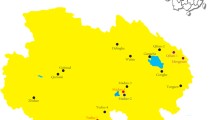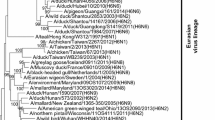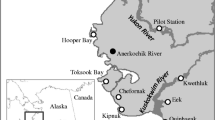Abstract
This study presents the results of the virologic analysis and year-round movements of a Southern Giant Petrel that tested positive for avian influenza virus. Data were collected in two areas of Antarctica, where 299 Southern Giant Petrel adults and chicks were sampled. One-step real-time RT-PCR detected the presence of the avian influenza A virus in only one individual of the total Southern Giant Petrel sampled. The H4N7 subtype detected was compared to other H4N7 virus sequences and results suggest that segments of E96/H4N7 were closely related to avian influenza viruses of Anseriformes and Charadriiformes from North America. The geolocator that reported the year-round movements of the infected Southern Giant Petrel was retrieved. It was observed that this infected individual visited areas close to the Antarctic Peninsula during summer/spring and migrated to northern areas near South America and the Falkland Islands during the non-breeding season. Our results point out the first evidence of avian influenza virus H4N7 in Giant Petrels. Furthermore, the genetic similarity of the sequenced virus provides evidence of viral connections between North America and the Antarctic Peninsula. The migratory routes of several species in which avian influenza virus has been detected are coincident with the non-breeding area frequented by this single Southern Giant Petrel. Thus, movements of Southern Giant Petrel should be monitored to enable the determination of potential points of contact with other coastal seabird species along with the assessment of the dispersal routes of viruses.




Similar content being viewed by others

References
Abad FX, Busquets N, Sanches A, Ryan PG, Majó N, Gonzales-Solís J (2013) Serological and virological surveys of the influenza A viruses in Antarctic and sub-Antarctic penguins. Antarct Sci 25:339–344. doi:10.1017/S0954102012001228
Alexander DJ (2000) A review of avian influenza in different bird species. Vet Microbiol 74:3–13. doi:10.1016/S0378-1135(00)00160-7
Alexander DJ (2007) An overview of the epidemiology of avian influenza. Vaccine 25:5637–5644. doi:10.1016/j.vaccine.2006.10.051
Araujo J, de Azevedo Júnior SM, Gaidet N, Hurtado RF, Walker D, Thomazelli LM, Ometto T, Seixas MMM, Rodrigues R, Galindo DB, da Silva ACS, Rodrigues AMM, Bomfim LL, Mota MA, Larrazábal ME, Branco JO, Serafini P, Neto IS, Franks J, Webby RJ, Webster RG, Durigon EL (2014) Avian influenza virus (H11N9) in Migratory Shorebirds Wintering in the Amazon Region, Brazil. PLoS One 9(10):e110141. doi:10.1371/journal.pone.0110141
Austin FJ, Webster RG (1993) Evidence of ortho- and paramyxoviruses in fauna from Antarctica. J Wildlife Dis 29:568–571. doi:10.7589/0090-3558-29.4.568
Barbosa A, Palacios MJ (2009) Health of Antarctic birds: a review of their parasites, pathogens and disease. Polar Biol 32:1095–1115. doi:10.1007/s00300-009-0640-3
Baumeister E, Leotta G, Pontoriero A, Campos A, Montaltu D, Vigo G, Pecoraro M, Savy V (2004) Serological evidences of influenza A virus infection in Antarctica migratory birds. Intern Congr Ser 1263:737–740. doi:10.1016/j.ics.2004.02.099
Boulinier T, Kada S, Ponchon A, Dupraz M, Dietrich M, Gamble A, Bourret V, Duriez O, Bazire R, Tornos J, Tverra T, Chambert T, Garnier R, McCoy KD (2016) Migration, prospecting, dispersal? What host movement matters for infectious agent circulation? Integr Com Biol. doi:10.1093/icb/icw015
Bowman AS, Sreevatsan S, Killian ML, Page SL, Nelson SW, Nolting JM, Cardona C, Slemons RD (2012) Molecular evidence for interspecies transmission of H3N2pM/H3N2v influenza A viruses at an Ohio agricultural fair, July 2012. Emerg Microbes Infect 1:1–8. doi:10.1038/emi.2012.33
Brown JD, Goekjian G, Poulson R, Valeika S, Stallknecht DE (2009) Avian influenza virus in water: infectivity is dependent on pH, salinity and temperature. Vet Microbiol 136:20–26. doi:10.1016/j.vetmic.2008.10.027
Cheng MC, Wang CH, Kida H (2004) Influenza A virological surveillance in feral waterfowl in Taiwan from 1998 to 2002. ICS 1263:745–748. doi:10.1016/j.ics/2004.02.013
Cheng MC, Lee MS, Ho YH, Chyi WL, Wang CH (2010) Avian influenza monitoring in migrating birds in Taiwan during 1998–2007. Avian Dis 54:109–114. doi:10.1637/8960-061709-Reg.1
Dashzevge E, Imai K, Ogawa H (2013) Phylogenic analysis of the M gener of influenza viruses isolated from shorebirds. J Agr Sci 11:7–12. doi:10.5564/mjas.v11i2.207
Delangue J, Sanchez YR, Piorkowski G, Bessaud M, Baronti C, Thirion_Perrier L, Mafayle RL, Aedaya CA, Aguilera GA, Guzman JR, Riera JL, de Lamballerie X (2014) Viral aetiology influenza like illnesses in Santa Cruz, Bolivia (2010–2012). Virol J 11:1–11. doi:10.1186/1743-422X-11-35
Elizalde M, Agüero M, Buitrago D, Yuste M, arias ML, Muños MJ, Lelli D, Péres-Ramíres E, Moreno-Martin AM, Fernández-Pinero J (2014) Rapid molecular haemagglutinin subtyping of avian influenza isolates by specific real-time TR-PCR tests. J Virol Methods 196:71–81. doi:10.1016/j.jviromet.2013.10.031
Gonzáles-Solís J, Croxall JP, Wood AG (2000) Foraging partitioning between Giant Petrel Macronectes spp., using different foraging strategies. Mar Biol 140:197–204. doi:10.3354/meps204279
Gonzáles-Solís J, Croxal JP, Afanasiev V (2008) Offshore spatial segregation in giant petrel Macronectes spp. : differences between species, sexes and seasons. Aquatic Conserv Mar Freshw Ecosyst 17:22–36. doi:10.1002/aqc.911
Grimaldi WW, Seddon PJ, Lyver PO’B, Nakagawa S, Tompkins DM (2015) Infectious diseases of Antarctic penguins: current status and future threats. Polar Biol 38:591–606. doi:10.1007/s00300-014-1632-5
Hanson BA, Luttrell MP, Goekjian VH, Niles L, Swayde DE, Senne DA, Stallknecht DE (2008) Is the occurrence of avian influenza virus in Charadriiformes species and location dependent? J Wildlife Dis 44:350–361. doi:10.7589/0090-3558-44.2.351
Hurt AC, Vijaykrishna D, Butler J, Bass C, Maurer-Stroh M, Sila-de-la-Fuente MC, Medina-Vogel G, Olsen B, Kelson A, Barr KI, González-Acuña D (2014) Detection of evolutionarily distinct avian influenza A in Antarctica. mBio 5:1–9. doi:10.1128/mBio.01098-14
Ito T, Okazaki K, Kawaoka Y, Takada A, Webster RG, Kida H (1995) Perpetuation of influenza A virus in Alaskan waters reservoirs. Arch Virol 140:1163–1172. doi:10.1007/BF01322743
ICTV (2014) ICTV master species list. International Committee of Taxonomy of Viruses. https://talk.ictvonline.org/files/master-species-lists/m/msl/5208?Redirected=true. Accessed 17 May 2016
Kawaoka Y, Neumann G (2012) Influenza virus: methods and protocols. Springer, Berlin
Kilpatric AM, Chmura AA, Gibbons DW, Fleischer RC, Marra PP, Daszak P (2006) Predicting the global spread of H5N1 avian influenza. PNAS 103:19368–19373. doi:10.1073/pnas.0609227103
Krauss S, Stallknecht DE, Negovetich NJ, Niles NJ, Webby RJ, Webster RG (2010) Coincident ruddy turnstone migration and horseshoe crab spawning creates an ecological “hot spot” for influenza viruses. Proc R Soc 277:3373–3379. doi:10.1098/rspb.2010.1090
Life Technologies (2014) http://tools.lifetechnologies.com/content/sfs/brochures/Consumables-Product-Selection-Guide.pdf. Accessed 03August 2014
Maxted AM (2011) Avian influenza viruses in shorebird hosts at the Delaware Bay migratory stopover site: infection patterns and dynamics, host ecology, and population effects. Dissertation, University of Georgia
Miller GD, Watts JM, Shellam GR (2008) Viral antibodies in south polar skuas around Davis Station, Antarctica. Antarct Sci 20:455–461. doi:10.1017/S0954102008001259
Munster JV, Baas C, Lexmond P, Waldenström J, Wallensten A, Fransson T, Rimmelzwann GF, Beyer WE, Schutten M, Olsen B, Osterhaus ADME, Fouchier RAM (2007) Spatial, temporal, and species variation in prevalence of influenza A viruses in wild migratory birds. Plos Pathogens 3:e61. doi:10.1371/journal.ppat.0030061
Nazir J, Haumacher R, Ike A, Stumpf P, Böhm R, Marschang RE (2010) Long-term study on tenacity of avian influenza viruses in water (distilled water, normal saline, and surface water) at different temperatures. Avian Dis 54:720–724. doi:10.1637/8754-033109-ResNote.1
Olsen B, Munster VJ, Wallensten A, Waldenstrom J, Osterhaus ADME e Fouchier RA (2006) Global patterns of Influenza A virus wild birds. Science 312:384–388. doi:10.1126/science.1122438
Patterson DL, Woehler EJ, Croxall JP, Cooper J, Poncet S, Peter HU, Hunter S, Fraser WR (2008) Breeding distribution and population status of the northern giant petrel Macronectes halli and the southern giant petrel M. giganteus. Mar Ornithol 36:115–124.
Perón C, Delord K, Phillips RA, Charbonnier Y, Marteau C, Louzao M, Weimerskirch H (2010) Seasonal variation in oceanographic habitat and behaviour of white-chinned petrels Procellaria aequinoctialis from Kerguelen Island. Mar Ecol Prog Ser 416:267–284. doi:10.3354/meps08785
Petersen ES, Rossi LC, Petry MV (2015) Records of vagrant birds species in Antarctica: new observations. Mar Biodivers Rec 8:61–67. doi:10.1017/S1755267215000378
Petry MV, Petersen ES, Scherer JFM, Krüger L, Scherer AL (2010) Nota sobre a ocorrência e dieta de Macronectes giganteus (Procellariiformes: Procellariidae) no Rio Grande do Sul, Brasil. Rev Bras Ornitol 18:237–239
Phillips RA, Silk JRD, Croxall JP, Afanasyev V, Briggs DR (2004) Accuracy of geolocation estimates for flying seabirds. Mar Ecol Prog Ser 266:265–272. doi:10.3354/meps266265
Quintana F, Dell’Arciprete OP, Copello S (2010) Foraging behaviour and habitat use by the Southern Giant Petrel on the Patagonian shelf. Mar Biol 157:515–525. doi:10.1007/s00227-009-1337-4
Senne DA (2010) Avian Influenza in North and South America, the Caribbean, and Australia, 2006–2008. Avian Dis 54:179–186. doi:10.1637/8921-050809-Review.1
Shoham D, Jahangir A, Ruenphet S, Takehara K (2012) Persistence of avian influenza viruses in various artificially frozen environmental water types. Influenza Res Treat. doi:10.1155/2012/912326
Stallknecht DE, Keraney MT, Shane SM, Zwank PJ (1990) Effects of pH, temperature and salinity on persistence of avian viruses in water. Avian Dis 34:412–418. doi:10.2307/1591429
Tong S, Li Y, Rivailler P, Conrardy C, Castillo DAA, Chen LM, Recuenco S, Ellison JA, Davis CT, York IA, Turmelle AS, Moran D, Rogers S, Shi M, Tao Y, Weil MR, Tang K, Rowe LA, Sammons S, Xu X, Frace M, Lindblade KA, Cox NJ, Anderson LJ, Rupprecht CE, Donis RO (2012) A distinct lineage of influenza A virus from bats. PNAS 13:4269–4274. doi:10.1073/pnas.1116200109
Wallensten A, Munster VJ, Osterhaus ADME, Waldenstöm J, Bonnedahl J, Broman T, Fouchier RAM, Olsen B (2007) Mounting evidence for the presence of influenza A virus in the avifauna of the Antarctic region. Antarct Sci 18:353–356. doi:10.1017/S095410200600040X
Webster RG, Yaknot M, Hinshaw VS, Bean WJ, Murti KC (1978) Intestinal Influenza: replication and characterization of influenza virus in ducks. Virology 84:268–278. doi:10.1016/0042-6822(78)90247-7
Webster RG, Bean WJ, Gorman OT, Chambers TM, Kawaoka Y (1992) Evolution and ecology of influenza A viruses. Microbiol Mol Biol Rev 56:152–179
Zhang G, Shoham D, Gilichinsky D, Davydov S, Castello JD, Rogers SO (2006) Evidence of Influenza A virus RNA in Siberian Lake Ice. J Virol 80:12229–12235. doi:10.1128/JVI.00986-06
Acknowledgements
This research has been supported by the National Institute of Science and Technology Antarctic Environmental Research (INCT-APA) that received technical and financial support from the National Council for Research and Development (CNPq process: No 574018/2008-5) and Carlos Chagas Research Support Foundation of the State of Rio de Janeiro (FAPERJ No E-16/170.023/2008), along with a CNPQ Ph.D. Grant (process: No 553238/20094). The authors also acknowledge the support from the Brazilian Ministries of Science, Technology and Innovation (MCTI), of Environment (MMA), the Brazilian Antarctic Program, the Secretariat of the Interministerial Commission for Sea Resources (SECIRM), the University of Vale do Rio dos Sinos, Laboratory BSL3+ of Microbiology of University of São Paulo, the American Lebanese Syrian Associated Charities (ALSAC), and Research Foundation (FAPESP 2011/13821-7). We would also like to thank all partners who worked in the field, specially at the sample collection.
Author information
Authors and Affiliations
Corresponding author
Ethics declarations
Conflict of interest
All authors claimed that they have no conflict of interest.
Ethical approval
All applicable international, national, and/or institutional guidelines for the care and use of animals were followed.
Additional information
Responsible Editor: U. Siebert.
Reviewed by Undisclosed experts.
Rights and permissions
About this article
Cite this article
de Souza Petersen, E., de Araujo, J., Krüger, L. et al. First detection of avian influenza virus (H4N7) in Giant Petrel monitored by geolocators in the Antarctic region. Mar Biol 164, 62 (2017). https://doi.org/10.1007/s00227-017-3086-0
Received:
Accepted:
Published:
DOI: https://doi.org/10.1007/s00227-017-3086-0



